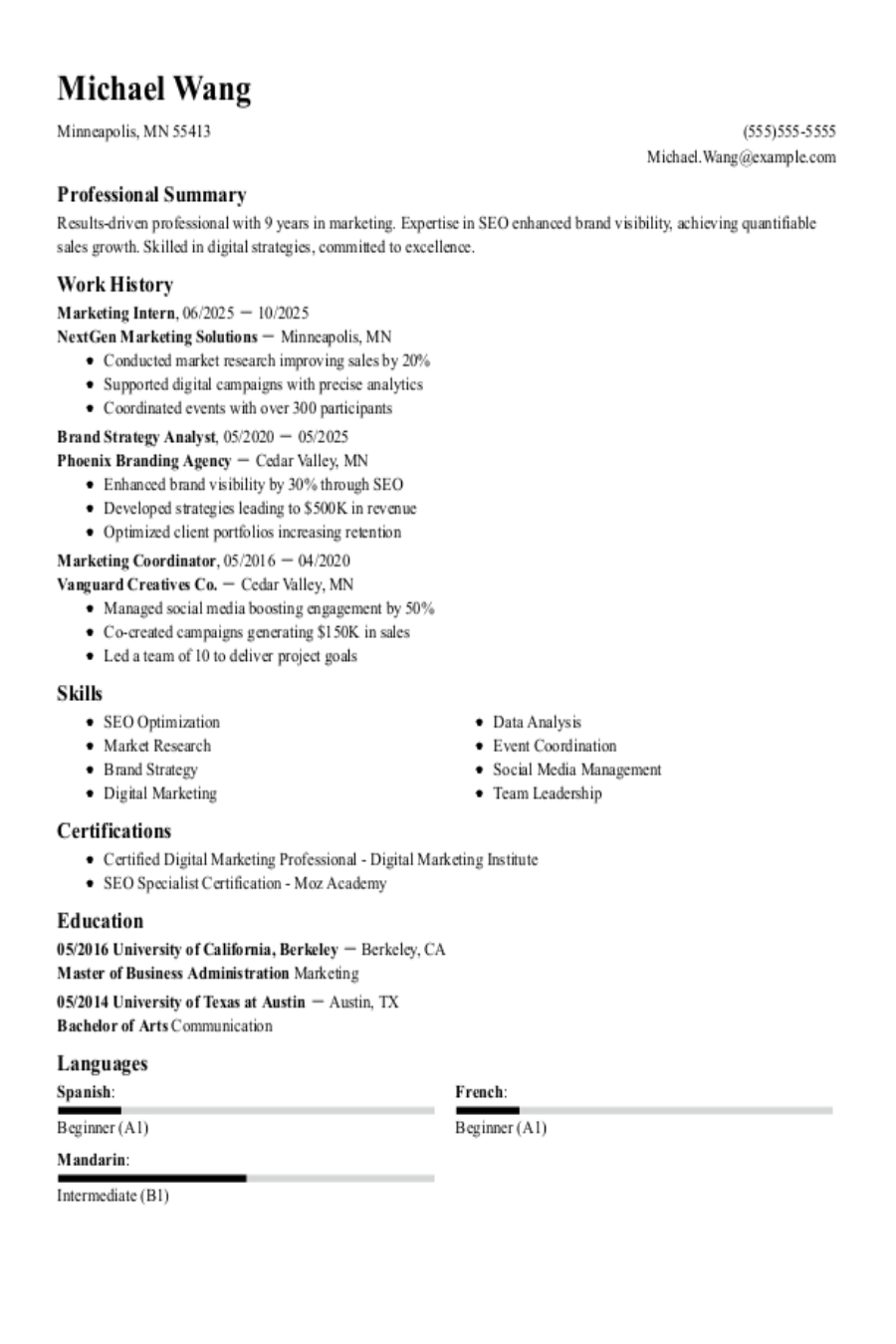Popular Er Nurse Resume Examples
Entry-level ER nurse resume
An entry-level resume for an ER nurse should highlight clinical rotations, certifications such as BLS and ACLS, relevant skills in patient care, and any volunteer experience that shows preparedness for the role.
Emphasis on soft skills: This resume highlights the job seeker's strong soft skills, such as teamwork and critical thinking, which effectively compensates for their lack of experience.
Clarity: Opting for a simple resume template allows your qualifications to shine through, making it easier for recruiters to quickly assess your skills and experiences at a glance.
Mid-career ER nurse resume
A mid-career ER nurse resume should emphasize a combination of clinical expertise, patient care skills, and ongoing professional development to effectively demonstrate their value to potential employers in the healthcare field.
Active language: Using strong action verbs such as "managed," "reduced," and "trained" highlights the strength of the job seeker's previous experience and showcases their proactive approach to patient care.
Neat template: A well-structured resume improves readability, allowing hiring managers to quickly identify key qualifications and achievements. Well-organized sections that use bullet points and bold font make it easy to highlight relevant experience.
Experienced ER nurse resume
An experienced ER nurse resume should highlight key achievements and clinical skills while effectively demonstrating a clear progression in responsibilities and expertise within emergency care settings.
Modern style: This modern resume template effectively showcases the applicant's professional brand, using strong visuals to highlight their commitment to improving patient care and streamlining emergency response operations.
Organized template: The resume uses a clean and modern template that combines a professional header with an ATS-friendly resume design, ensuring it's clear to human recruiters while also being compatible with automated screening tools.
No experience ER nurse resume
A resume for an applicant with no experience for an entry-level ER nurse should highlight relevant clinical skills, certifications, and any volunteer experiences to showcase the job seeker's preparedness and commitment to providing quality patient care in a fast-paced environment.
Emphasis on relevant skills: By emphasizing professional skills like patient assessment over work experience, this resume shows the job seeker's preparedness for an entry-level role, even without the hands-on experience.
Avoids jargon: Job seekers often feel inclined to embellish their resumes with complex language or technical terms to showcase basic experiences. However, a straightforward presentation of skills using simple and clear language often resonates more effectively with potential employers.
More resume examples
Additional Guides
- Medical Surgery Nurse
- Neonatal Intensive Care Nurse
- New Grad Nurse
- Nurse Manager
- Nurse Midwife
- Nurse Practitioner
- Nurse Supervisor
- Occupational Health Nurse
- Oncology Nurse
- Operating Room Nurse
- Pediatric Nurse
- Perioperative Nurse
- Post Anesthesia Nurse
- Progressive Care Nurse
- Registered Nurse
- RN Unit Manager
- School Nurse
- Student
- Travel Nurse
- Utilization Review Manager
ER Nurse Resume Template
Looking to create a standout application? This professional ER nurse resume template is a great foundation—simply copy and paste, then personalize it with your own details and experiences.
Aiko Yamamoto
San Diego, CA 92102
(555)555-5555
Aiko.Yamamoto@example.com
Professional Summary
Dedicated ER Nurse with 8 years' experience in high-pressure environments. Expert in emergency response, patient assessment, and healthcare management. Passionate about improving patient care outcomes.
Work History
ER Nurse
Harmony Health Center - San Diego, CA
March 2023 - August 2025
- Managed 20 patient admissions daily
- Facilitated triage and treatment plans
- Achieved 15% improvement in ER efficiency
Critical Care Nurse
Riverside Medical Group - San Francisco, CA
May 2019 - February 2023
- Reduced inpatient waiting time by 20%
- Performed emergency interventions
- Collaborated on complex cases daily
Registered Nurse
Greenfield Hospital - San Diego, CA
August 2017 - May 2019
- Administered meds to 30 patients daily
- Implemented care protocols effectively
- Supervised junior staff with training
Languages
- Spanish - Beginner (A1)
- French - Beginner (A1)
- Mandarin - Beginner (A1)
Skills
- Critical Care
- Emergency Response
- Patient Assessment
- Team Leadership
- Communication
- Stress Management
- Healthcare Management
- Patient Education
Certifications
- Certified Emergency Nurse - Board of Certification for Emergency Nursing
- Basic Life Support - American Heart Association
Education
Master of Science Nursing
University of Washington Seattle, WA
June 2017
Bachelor of Science Nursing
Seattle Pacific University Seattle, WA
June 2015
Writing Your ER Nurse Resume
Having explored some excellent resume examples, you're now primed to dive into the process of making your own. We'll walk you through every aspect of how to write a resume, offering pro tips for each section along the way.
List your most relevant skills
Crafting an effective skills section for your ER nurse resume means highlighting both technical abilities, like patient assessment and emergency response, and essential soft skills such as teamwork and communication. By aligning these skills with the keywords from the job listing, you demonstrate your readiness for the role.
Using keywords from the job listing not only helps human recruiters quickly identify your fit but also increases your chances of passing applicant tracking systems (ATS). Incorporate terms like "critical care" or "triage" that are mentioned in the posting to ensure you resonate with what employers are seeking. This strategic approach positions you as a strong applicant who meets their needs effectively.
Example of skills on a er nurse resume
- Proficient in administering medications and monitoring patient responses
- Strong communication skills for effective collaboration with healthcare teams
- Compassionate caregiver dedicated to improving patient comfort and wellbeing
- Adept at managing multiple tasks in a fast-paced environment
Your resume should combine the essential technical skills specified in the job description with key soft skills, illustrating your capability to meet the demands of this challenging role. This balance showcases your ability to thrive in a fast-paced environment.
Highlight your work history
Your work experience section is an important part of your resume. This section should detail your job responsibilities and emphasize your achievements in a fast-paced environment. Highlight how you used your clinical skills and provided exceptional patient care, making sure to include relevant keywords that will catch the attention of hiring managers.
For each job entry, provide key details such as your title, the name of the hospital or healthcare facility, and the dates you were employed. Including this information establishes your professional credibility and helps potential employers understand your background at a glance. Focus on specific accomplishments to illustrate how you contributed to patient outcomes and team efficiency.
Example of an ER nurse work experience entry
- ER Nurse
City Hospital - Dallas, TX
June 2021 - Present - Provide high-quality emergency care to an average of 30 patients daily in a fast-paced environment, ensuring timely assessments and interventions
- Administer medications and treatments following protocols, achieving a patient recovery rate of over 90%
- Collaborate with multidisciplinary teams to develop and implement effective patient care plans, improving overall departmental efficiency by 15%
- Mentor and orient new nursing staff on emergency procedures and best practices, fostering a supportive learning environment that improved team performance
- Use electronic health record systems to accurately document patient information, contributing to streamlined operations and improved patient safety.
Quantifying achievements as an ER nurse is vital to illustrate the impact of your care on patient outcomes. For example, reporting a 40% reduction in patient wait times during peak hours highlights your ability to optimize workflow and improve patient satisfaction effectively.
Include your education
The education section of your resume should list your academic credentials in reverse-chronological order, starting with the most recent degree. Include any nursing diplomas or degrees, and feel free to leave out your high school diploma if you possess a higher qualification. Remember to highlight any honors or distinctions that can help set you apart from other job seekers.
If you are currently enrolled in a nursing program or have not completed your education, indicate your highest level of education achieved along with an expected graduation date. Additionally, including relevant coursework and academic achievements can be helpful, especially for recent graduates or students. These details can showcase your preparedness for the role and emphasize areas of expertise relevant to emergency nursing.
Common certifications for an ER nurse resume
- Certified Emergency Nurse (CEN) – Board of Certification for Emergency Nursing (BCEN)
- Trauma Certified Registered Nurse (TCRN) – BCEN
- Pediatric Advanced Life Support (PALS) – American Heart Association (AHA)
- Advanced Cardiovascular Life Support (ACLS) – AHA
Sum up your resume with an introduction
The opening profile of your nursing resume functions as your personal elevator pitch, designed to immediately convey your professional strengths and potential contributions. A thoughtfully crafted profile can significantly increase your chances of securing an interview by making a positive first impression.
When developing this section, consider whether a professional summary or resume objective better serves your needs. Professional summaries work exceptionally well for candidates with established careers, enabling them to showcase quantifiable achievements and proven performance. Resume objectives are particularly valuable for recent graduates or professionals transitioning from other fields, providing a platform to emphasize relevant academic preparation and clear objectives.
Professional summary example
Compassionate ER nurse with over 5 years of experience in high-pressure emergency settings. Demonstrated success in delivering critical care to diverse patient populations, effectively managing trauma cases, and improving patient outcomes through rapid assessment and intervention. Proficient in advanced life support techniques, medication administration, and collaborative team coordination to ensure the highest standards of emergency healthcare.
Resume objective example
Compassionate ER nurse eager to use strong patient assessment, critical thinking, and teamwork skills in a fast-paced healthcare environment. Committed to providing high-quality care and improving patient experiences while contributing positively to the emergency department's success.
Your resume profile should prominently feature your job title right at the beginning. This approach helps you convey your professional identity instantly, allowing employers to quickly understand who you are and what expertise you bring to the table.
Add unique sections to set you apart
Incorporating optional resume sections can improve your application for ER nurse positions by highlighting your unique qualifications. These sections allow you to bring attention to skills and experiences that set you apart from other job seekers.
These additional sections can reveal various facets of your professional persona, such as relevant hobbies or volunteer work that align with the values of nursing. For instance, showcasing time spent on community health initiatives or participating in medical outreach programs demonstrates both commitment and compassion. By illustrating how you engage with the community, you not only improve your resume but also provide insight into your working style and dedication to patient care.
Three sections perfect for a er nurse resume
- Languages: If you're bilingual, language skills should be highlighted on your resume to improve patient interaction and improve care quality in diverse healthcare settings.
- Volunteer Work: Including volunteer work on a resume often showcases valuable skills that improve your professional profile. It serves as a testament to your dedication and community involvement.
- Achievements: Quantifiable accomplishments highlight your effectiveness in delivering patient care. You can showcase metrics like reducing wait times by 25% or improving patient satisfaction scores by 15%.
5 Resume Formatting Tips
- Choose a format that matches your career stage.
Choosing the right resume format can showcase your experience effectively. If you’re an experienced ER nurse, a chronological format highlights your career progression and achievements. For those just starting out or with less experience, a functional resume emphasizes skills over job history. Consider a combination format if you want to showcase both skills and work history equally. Tailor your choice to reflect your unique journey in nursing.
- Pick a smart resume template.
Consider using a professional resume template to make your resume more readable. This helps ensure that your information stands out to hiring managers. If you opt for a custom format, prioritize simplicity and use fonts that are friendly to applicant tracking systems (ATS) to avoid any formatting issues.
- Use an appropriate font.
Opt for a legible and well-known professional font. Fonts like Arial, Calibri, or Helvetica are excellent choices, ensuring that both ATS systems and hiring managers can easily read your qualifications without distraction.
- Use consistent formatting.
Your resume should be neatly aligned with uniform margins to create a polished and professional look that catches the eye of hiring managers.
- Keep your resume to one or two pages.
Remember that resumes should be one page long in most scenarios. However, if you have extensive experience, a two-page format can work as long as every detail is relevant and clearly presented. Regardless, keep your content concise to maintain the reader's interest.
Tools for Your Job Search
Are you gearing up to apply for that coveted emergency room nurse position? Before you hit submit, make sure your resume is ready with our ATS Resume Checker. This essential tool analyzes how well your resume will perform against the automated systems many healthcare organizations use for initial job seeker screening.
To further improve your application, explore our AI Resume Builder. It offers tailored recommendations specifically designed for emergency room nursing, along with professional templates that showcase your clinical expertise and qualifications effectively to hiring managers.
Frequently Asked Questions
Last Updated: August 22, 2025
Absolutely. A cover letter adds depth to your resume and provides an invaluable opportunity for you to connect with potential employers. It allows you to express your passion for the role and highlight how your specific skills and experiences make you an ideal applicant. Don’t hesitate—write a cover letter that showcases who you are beyond the bullet points.
For an easy solution, consider using our AI Cover Letter Generator! It streamlines the process of crafting a personalized cover letter tailored to the job you're applying for in just minutes. Plus, you can select from various cover letter template options that perfectly complement your resume, making your application even more cohesive and compelling.
A resume is generally a concise document, typically spanning one to two pages, focusing on your relevant work experience and skills. In contrast, a curriculum vitae (CV) can be several pages long and includes comprehensive details about your academic background, research contributions, publications, and extensive professional history.
You should use a CV when applying for positions in academia, research roles, or specialized fields such as medicine and law. If you need to create a standout CV quickly, our online CV Maker is the perfect solution. Choose from our various tailored CV templates designed for different industries and career levels to effortlessly craft your professional document.
Choosing the right resume format will help you showcase your strengths based on your career level. Inexperienced job seekers should opt for a functional format that highlights relevant skills over work history. Conversely, experienced professionals benefit from a chronological format that details their job experiences in order. For those at mid-level positions, a combination format strikes a balance by presenting both skills and experience effectively, making it easier to catch the eye of potential employers.
To tailor your resume effectively, focus on highlighting the essential skills that match the job description. Review job listings closely to pinpoint key phrases and requirements. Incorporate these keywords into your resume to clearly demonstrate how your experience aligns with the role, showcasing your qualifications in a way that resonates with potential employers.
Stay on top of the latest trends by actively pursuing continuing education and certifications that improve your skills. Engage with professional associations, keep abreast of industry developments through publications, and participate in relevant training programs or workshops. This proactive approach not only bolsters your expertise but also showcases your commitment to excellence in patient care.
Consider earning relevant certifications and listing them on your resume. Additionally, highlight any courses you've taken or seminars you've attended. Regularly reading industry-related books and listening to informative podcasts can also reflect your commitment. Don't forget to mention memberships in professional organizations, as they exemplify your engagement with ongoing developments in the field.
Was this information helpful? Let us know!
Hailey is a career advice writer dedicated to helping job seekers excel in their careers.
More resources

How to Use Resume Now’s Resume Builder for Free
Try Resume Now s AI-powered Resume Builder for free to access ...

How to Include Networking Skills on a Resume (40+ Examples, Definition & Tips to Improve)
What are networking skills? We ll answer this and all your p...

Medical Resume: Examples, Templates & Tips
Check out our resume examples for help getting your medical re...

Manager Resume: Examples, Templates & Tips for 2025
As a manager you can take on a lot of responsibility. Now ch...



